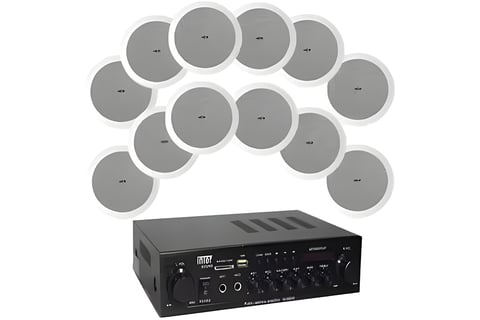Internal Sound Systems
Internal sound systems deliver high-quality audio throughout indoor spaces, ranging from simple stereo setups to complex multi-room configurations.
Internal sound systems, also known as indoor audio systems, are designed to deliver high-quality sound throughout a home, office, or other indoor spaces. These systems can range from simple setups to complex configurations, depending on your needs and preferences. Here's an overview of different types, key features, and considerations for internal sound systems:
### Types of Internal Sound Systems
1. Stereo Systems
- Design: Typically consists of two speakers (left and right) and an amplifier.
- Use: Ideal for basic audio needs, providing good sound quality for music and TV.
2. Home Theater Systems
- Design: Includes multiple speakers (usually a 5.1 or 7.1 setup) and a subwoofer for a surround sound experience.
- Use: Enhances movie watching with immersive audio, creating a cinema-like experience at home.
3. Multi-Room Audio Systems
- Design: Uses multiple speakers placed in different rooms, all controlled from a central system.
- Use: Allows you to play the same or different audio in various rooms, often with wireless or networked connectivity.
4. Whole-House Audio Systems
- Design: Wired or wireless system integrated throughout the house, typically controlled via a central panel or mobile app.
- Use: Provides seamless audio coverage throughout the entire home, including indoor and outdoor spaces.
5. In-Wall and In-Ceiling Speakers
- Design: Speakers are mounted flush with the wall or ceiling, providing a discreet audio solution.
- Use: Ideal for a clean look and unobtrusive audio distribution.
6. Bluetooth Speakers
- Design: Portable and connects wirelessly to devices via Bluetooth.
- Use: Good for individual rooms or areas where a wireless, easy-to-move option is preferred.
7. Smart Speakers
- Design: Speakers with built-in voice assistants (e.g., Amazon Alexa, Google Assistant) that can control other smart home devices.
- Use: Provides voice-controlled audio and integration with smart home systems.
### Key Features
1. Audio Quality
- Look for systems that offer clear, balanced sound with good bass, midrange, and treble frequencies.
2. Connectivity
- Wired Connections: RCA, optical, or HDMI for high-quality, stable audio.
- Wireless Connections: Bluetooth, Wi-Fi, or network-based streaming for flexibility and convenience.
3. Control Options
- Remote Control: Allows for easy adjustment of volume, settings, and source selection.
- Mobile App: Provides control from smartphones or tablets, often with additional features like playlists and equalizer settings.
- Voice Control: Available with smart speakers and integrated systems.
4. Zone Control
- Allows for independent audio control in different rooms or zones, so you can play different music in different areas.
5. Integration with Home Automation
- Compatibility with smart home systems for synchronized control with lighting, heating, and other systems.
6. Amplification
- Built-in amplifiers or separate amplifiers to drive speakers and ensure adequate sound levels.
7. Streaming Services
- Support for streaming music services (e.g., Spotify, Apple Music) for easy access to a wide range of content.
### Benefits
1. Enhanced Audio Experience: Provides high-quality sound for music, movies, and TV shows, improving overall enjoyment.
2. Customizable Sound: Systems can be tailored to fit the acoustics of different rooms and preferences.
3. Convenience: Multi-room and whole-house systems allow for seamless audio throughout the home.
4. Aesthetic Integration: In-wall and in-ceiling options blend with interior design, keeping the system discreet.
### Considerations
1. Room Acoustics: The size and shape of the room can affect sound quality. Consider acoustic treatments or speaker placement adjustments if needed.
2. Installation: Professional installation might be required for complex setups, especially for whole-house systems or in-wall speakers.
3. Budget: Costs can vary widely depending on the type of system and the features included. Determine your budget and prioritize features accordingly.
4. Future Upgrades: Choose a system that can be easily upgraded or expanded if your audio needs change.
### Installation Tips
- Speaker Placement: For optimal sound quality, position speakers according to the system's specifications. For home theaters, position speakers around the viewing area for surround sound.
- Cable Management: For wired systems, ensure cables are neatly routed and hidden for a clean appearance.
- Calibration: Many systems come with calibration tools or features to adjust sound settings based on room acoustics.
Internal sound systems can greatly enhance your auditory experience, whether you're looking for a simple stereo setup or a comprehensive whole-house audio solution. Choosing the right system depends on your specific needs, room layout, and personal preferences.


Call Us: +971567171303 - +971563030213
Address
Abu Dhabi ,UAE
Subscribe to our offer's
Contacts
+971567171303
+971563030213
info@bing-electric.com
BING ELECTRIC.
Call now and do not hesitate
